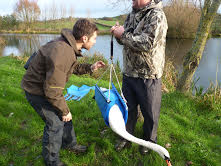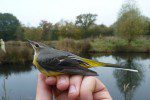May Update
Unfortunately the author of these updates has been too busy to spend as much time as he’d like at the Ponds during May, but a couple of visits late in the month did show summer was well underway.
As expected the usual water birds have young, including Mallard, Moorhen, Coot, Little Grebe (pictured below right) and of course Mute Swan…
When photographed there were seven cygnets, this was lower than the number that fledged the nest, but will probably be more than are still going at the end of the summer season. Nature can be harsh, but this is precisely why water birds have such large numbers of young.
Other summering birds present include numerous Chiffchaffs, Blackcaps and this year three singing  male Reed Warblers. Only two males Reed Warblers were present last year, but the increase in reed fringes around some of the ponds has done the trick and the Ponds breeding population of this species has increased by 50%.
male Reed Warblers. Only two males Reed Warblers were present last year, but the increase in reed fringes around some of the ponds has done the trick and the Ponds breeding population of this species has increased by 50%.









